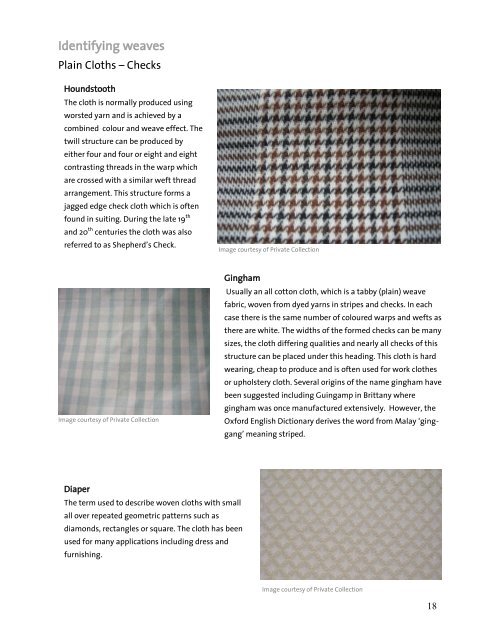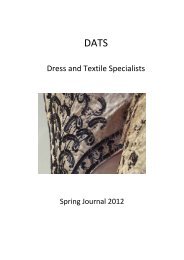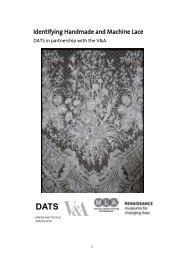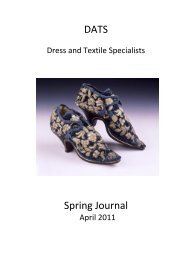Identifying Textile Types and Weaves 1750-1950 - Dress and Textile ...
Identifying Textile Types and Weaves 1750-1950 - Dress and Textile ...
Identifying Textile Types and Weaves 1750-1950 - Dress and Textile ...
Create successful ePaper yourself
Turn your PDF publications into a flip-book with our unique Google optimized e-Paper software.
<strong>Identifying</strong> weaves<br />
Plain Cloths – Checks<br />
Houndstooth<br />
The cloth is normally produced using<br />
worsted yarn <strong>and</strong> is achieved by a<br />
combined colour <strong>and</strong> weave effect. The<br />
twill structure can be produced by<br />
either four <strong>and</strong> four or eight <strong>and</strong> eight<br />
contrasting threads in the warp which<br />
are crossed with a similar weft thread<br />
arrangement. This structure forms a<br />
jagged edge check cloth which is often<br />
found in suiting. During the late 19 th<br />
<strong>and</strong> 20 th centuries the cloth was also<br />
referred to as Shepherd‟s Check.<br />
Image courtesy of Private Collection<br />
Diaper<br />
Image courtesy of Private Collection<br />
houndstooth<br />
The term used to describe woven cloths with small<br />
all over repeated geometric patterns such as<br />
Gingham<br />
diamonds, rectangles or square. The cloth has been<br />
used for many applications including dress <strong>and</strong><br />
furnishing.<br />
Usually an all cotton cloth, which is a tabby (plain) weave<br />
fabric, woven from dyed yarns in stripes <strong>and</strong> checks. In each<br />
case there is the same number of coloured warps <strong>and</strong> wefts as<br />
there are white. The widths of the formed checks can be many<br />
sizes, the cloth differing qualities <strong>and</strong> nearly all checks of this<br />
structure can be placed under this heading. This cloth is hard<br />
wearing, cheap to produce <strong>and</strong> is often used for work clothes<br />
or upholstery cloth. Several origins of the name gingham have<br />
been suggested including Guingamp in Brittany where<br />
gingham was once manufactured extensively. However, the<br />
Oxford English Dictionary derives the word from Malay „ging-<br />
gang‟ meaning striped.<br />
Image courtesy of Private Collection<br />
18





